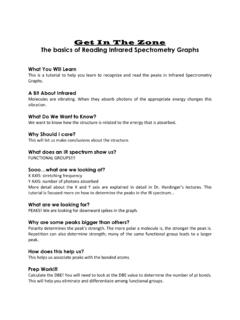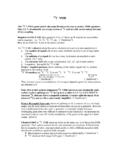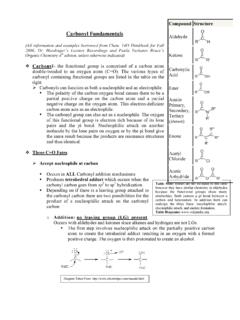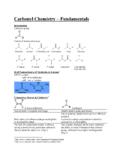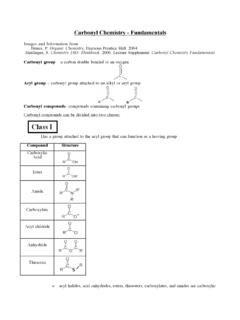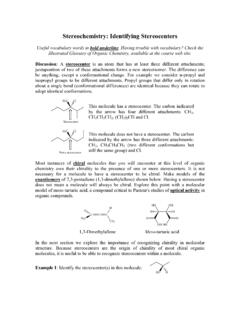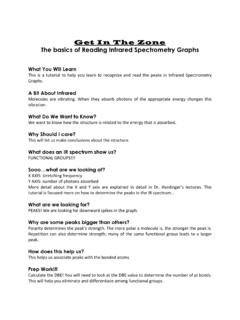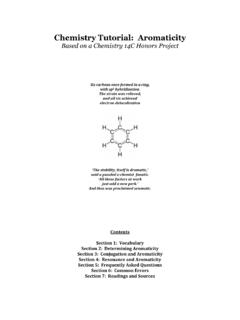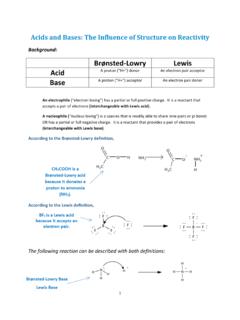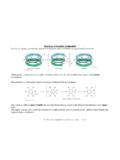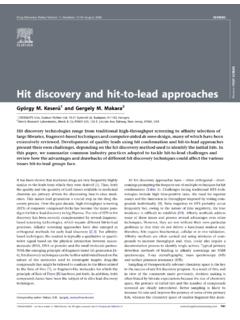Transcription of Carbonyl Chemistry: Survey of Reactions and …
1 Carbonyl Chemistry: Survey of Reactions andMechanismsCourse NotesChemistry 14 DImages and sample reactionstaken from the Chemistry 14 DThinkbook for Fall 2004, andOrganic Chemistryby Paula Yurkanis Bruice 4th editionCarbonyl Chemistry: Survey of Reactions and Mechanisms:When dealing with Carbonyls, we consider two general mechanism types:CarbonylsHave X as a Leaving GroupDon t have X as a Leaving GroupCarboxylic Acid (RCO2H)Aldehyde (RCHO)Acyl Halide (ROX)Ketone (RCOR )Acid Anhydride (RCO2 COR )Ester (RCO2R )Amide (RCONR 2)Nitrile (RCN) (doesn t look like a Carbonyl because it doesn thave a C=O but it reacts very similarly) H3C C=N2).. we then get atetrahedralintermediate whosefate is determined bythe presence of aleaving group1) we start withthe is attackedby the nucleophile3b).
2 If X is NOT a leaving group, the O- accepts a H+ and the result is an ADDITION REACTION3a) ..If X is a leaving group, then you kick out the leavinggroup and the result is a SUBSTITUTION REACTION. Another tetrahedralintermediate is formed. The HOCH3+ isdeprotonated by the :Band ultimately, the ketalis formed, as shown in thepink O Survey of ReactionsI. HEMIACETAL/ACETAL and HEMIKETAL/KETAL FORMATIONA ldehyde Hemiacetal Acetal Ketone Hemiketal Ketal Ketone/aldehyde + alcohol = hemiacetal/hemiketal after one equivalent of alcohol = acetal/ketal after two equivalents of alcohol*hemiacetal, hemiketal, and half all start with the letter h, this is areminder that when you produce the hemiacetal or hemiketal, you arehalfway to the acetal/ketal A hemiaceta/hemiketal has a carbon attached to an ether on one end and an alcohol on RO C OH An acetal/ketal has a carbon that is attached to two ethers.
3 If you take a hemiacetal andreplace the OH with an OR group then you get an RO C OR First, let us look at a generic mechanism for the formation of an acetal or ketal. Here, we start with theketone, so we will be forming a hemiketal, and then a ketal. In step 1) the oxygen is protonated. This makes the Carbonyl carbon more electrophilic bygiving it a greater partial positive charge Then the first equivalent of alcohol attacks the electrophile in step 2) Then, the tetrahedral intermediate is formed, when this is deprotonated by the :B, the hemiketalis formed as seen inside the orange box The mechanism doesn t stop the remaining alcohol group on the molecule is protonatedby H B+, to form H2O as a leaving group, with this, a double bond is formed.
4 Then, the second equivalent of alcohol attacks the electrophilic Carbonyl carbon 1)2)NO!! This is not valid because 4 member ringintermediate has ring strain! There is a 1,3 H- shift This does not happen because of the nature ofthe orbitals This process if forbiddenNow let s look at an example of an intramolecular formation of hemiacetal as seen in the assembly ofcyclic glucopyranose from acyclic glucose. This is an addition reaction where a nucleophilic alcohol attacks the most reactive part of themolecule, which is the aldehyde. Since we are focusing on the aldehyde, let the rest of the glucose loop structure be denotedby Mechanism: * remember that this whole process is reversible.
5 In step 1) the alcohol attacks the Carbonyl carbon, forming the tetrahedral intermediate found instep 2). The H2O here serves as a catalyst The OH is underlined in bold yellow; it serves as a protonbus in the reaction by shuttling the proton around. For instance in the second step, itprotonates the negatively charged oxygen in the second step. In the third step, it deprotonatesthe alcohol. Why should we protonate the O- before deprotonating the +OH? In this case, itdoesn t really matter what the sequence of the proton transfer is. The final product is formed and water is regenerated in step 4).Is the following a valid mechanism step?How to speed up the reaction:We start with thisacyclic glucoseWe get these two diastereomers asproducts through identicalmechanisms 1)2) 3)4)Why are hemiacetal/acetal and hemiketal/ketal formation faster in the presence of an acid?
6 Because alcohol is a poor nucleophile , it usually helps to have an acid catalyst. Protonatingthe alkoxide (RO-) of the tetrahedral intermediate shifts the equilibrium towards the productside. Additionally, acid can protonate the Carbonyl oxygen, this increases the electrophilicity of thecarbonyl are hemiacetal/acetal and hemiketal/ketal formation faster in the presence of a base? Deprotonating the tetrahedral intermediate s oxonium ion (R2OH+) makes the deprotonatedatom a poorer leaving group. The deprotonation also converts the weakly nucleophilic alcohol into a stronger would this reaction occur in a living cell? Inside a living cell, the proton shuttle is more likely to be an enzyme containing a sufficientlyacidic proton and the lone pair would function as the IMINE FORMATIONA ldehyde/Ketone + Primary Amine = Imine Imine: is a compound with a C=N bond Imine formation requires small amount of catalytic acid An example of this is the reaction of retinal & opsin to form rhodopsinIn the mechanism, we will use: RNH2 as the opsin and HO= as the retinalretmechanism for imine formation.
7 First, the amine attacks the Carbonyl carbon as seen in step 1 Then, the alkoxide (O-) gains a proton (2a) and the Nitrogen loses a proton (2b) to form aneutral tetrahedral intermediateo The equilibrium favors the tetrahedral intermediate with nitrogen protonated becausenitrogen is more basic than oxygen, it can be forced towards the imine by removing water Precipitation of imine produced At this point in the reaction, you might be wondering, why not protonate the Oxygen since youwant water to leave? As you can see in 3 this structure has a positive charge on the nitrogen,protonating the oxygen would put a positive charge on the oxygen. This would lead to positivecharges on the same molecule in close vicinity to each other which is unfavorable, hence weneed to deprotonate the positively charged nitrogen first in 3.
8 Now, in 4 we protonate the alcohol Starting with step 5 we see that the water leaves and a carbocation intermediate is formed thathas resonance with the nitrogen, once this is protonated, it forms the protonated imine which isthen deprotonated to yield the imine. This proceeds in an E1 like fashion The reaction can also proceed in an E2 like fashion that was see in 5b, with the elimination ofwater occurring at the same time another water deprotonates the nitrogen so it can form a newN=C bond, forming the imine. The mechanism step shown below CANNOT REALLY HAPPEN in a lab. It can only reallyhappen in an enzyme where the substrate is held tightly. Why can t it happen?
9 Because it is aTRIMOLECULAR COLLISION, which is unlikely. How do imines compare with carbonyls?CarbonylsIminesNucleophilicatt ack at thecarbon~ Carbonyl can react because of + on Carbonyl carbon oxygen can readily accept pairof electrons on C O pi bond O-H2O- ==O +OH2~ carbon of an imine has smaller + because nitrogenis less electronegative can not accept electrons in theC N pi bond as readily asoxygen of a Carbonyl ~imine is less readily attacked bynucleophiles than a Carbonyl CH3 -NCH3HO- ==N OHElectrophilicattack at theOxygen (inthe case ofcarbonyls)
10 OrNitrogen (inthe case ofimines)~ Carbonyl can react because of twolone pairs on oxygen + + HH2O H ==O ==O + H2O~imine nitrogen has a lone pair and isless electronegative than oxygen~imines will react more readily withelectrophiles than a Carbonyl CH3 + HH2O H ==N ==N+ + CH3 H2 OEnolateformation~same number of resonance forms asthe imine~ same number of resonance forms asthe
